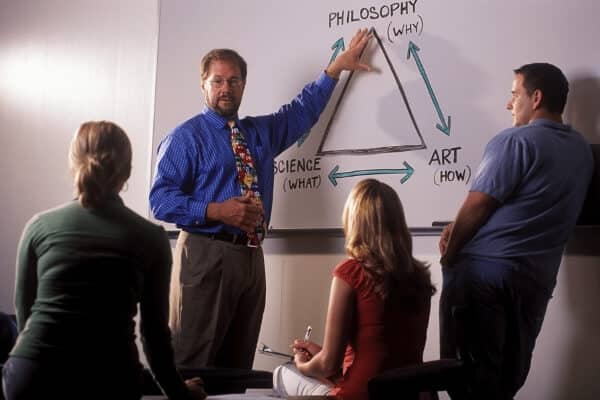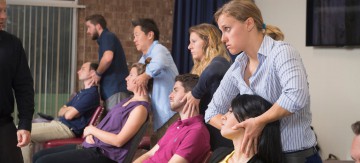[et_pb_section bb_built=”1″ admin_label=”section”][et_pb_row admin_label=”row” background_position=”top_left” background_repeat=”repeat” background_size=”initial”][et_pb_column type=”4_4″][et_pb_text _builder_version=”3.0.93″ background_layout=”light” border_style=”solid” header_text_align=”center”]
An Introduction to the Principles of Chiropractic Philosophy
[/et_pb_text][et_pb_text _builder_version=”3.0.98″ background_layout=”light”]
For chiropractic students who love the simplicity – and the concreteness – of working with their hands, the abstract realm of philosophy may seem a bit nebulous and intimidating. While they might certainly expect to learn about anatomy and physiology in great detail, chances are an aspiring D.C. is not anticipating delving into metaphysics during the course of their training!
Read on to discover why metaphysics does indeed matter, and how the philosophy of chiropractic touches every aspect of the profession.
More Than Meets the Eye: The Nature of Life and Health
Genuine learning and progress come from asking questions – the kinds of questions that prompt a closer look at accepted theories and practices, and push the boundaries of the status quo.
Students in chiropractic college test their assumptions about the body by inquiring into the metaphysics of human life and health, considering questions like, “Does life consist of physical and chemical processes working together, or is there more?”
Chiropractic philosophy maintains that there is indeed more to the body’s workings than meets the eye.
D.C.s often refer to this unseen element as a “vital” force that operates behind the physical body we observe. There are several ways to think about this force; founder of chiropractic philosophy, B.J. Palmer called it the body’s innate intelligence. Sherman College refers to it as the “principle of organization in living things,” emphasizing that the harmonious alignment between the physical body and this unseen force is necessary for us to enjoy optimal health.
The Difference between a State of Ease and a State of Dis-ease
According to chiropractic philosophy, we are in a “state of ease” when the body’s innate intelligence is able to properly express itself through our physical form. We are hampered by a loss of function, disharmony, and experience dis-ease when something interferes with that expression – such as a vertebral subluxation.
Subluxation occurs when a vertebra (one of the bones of the spine) impedes the transmission of information along the spine and throughout the central nervous system. These lost messages to and from the brain disrupt the body’s functioning as a whole. Chiropractic seeks to restore the communication flow with spinal adjustment. The chiropractor delivers a force that the person’s body can use to correct the subluxation, facilitating the body’s natural ability to adapt, regulate and heal itself, through its own innate intelligence.
Enhancing Health, not Treating Symptoms
The idea that chiropractors facilitate natural, holistic healing – rather than treat the symptoms of dis-ease – is foundational to the philosophy of chiropractic. This concept may be difficult for clients to initially understand, particularly if they subscribe to a more conventional model of healthcare in which an intervention is sought only when pain or dysfunction arises.
Throughout their chiropractic careers, D.C.s often take on the role of educators, helping their clients understand that regular adjustments should be integrated into their comprehensive healthcare plan. Dr. Decken, Chair of the Philosophy Department at Sherman College, says that ignoring the benefits of regular chiropractic care is “like an athlete not tying his/her shoes tightly for competition. They can still compete but their ‘equipment’ will not perform to the best of its ability, or design.”
Chiropractic education emphasizes that although plans of care are customized for each client, chiropractic is beneficial for virtually anyone who seeks to live in a state of ease and optimal health. From newborn babies and teens to adults and seniors – we can all benefit from having our most precious ‘equipment’ tuned up by expert hands.
Serving others by helping them maintain optimal health through natural means – this is the chiropractors’ mission and the philosophy that guides instruction at Sherman College of Chiropractic.
Click here to learn more about Sherman’s Chiropractic training program.
What element of chiropractic philosophy do you find most intriguing or inspiring?
[/et_pb_text][/et_pb_column][/et_pb_row][et_pb_row _builder_version=”3.0.49″ background_position_1=”top_left” background_repeat_1=”no-repeat” background_position_2=”top_left” background_repeat_2=”no-repeat” background_position_3=”top_left” background_repeat_3=”no-repeat”][et_pb_column type=”1_3″][et_pb_post_nav _builder_version=”3.0.49″ in_same_term=”off” hide_prev=”off” hide_next=”on” border_style=”solid” border_color=”#0c71c3″ title_font=”|on|||” title_font_size=”16px” show_prev=”on” show_next=”off” /][/et_pb_column][et_pb_column type=”1_3″][/et_pb_column][et_pb_column type=”1_3″][et_pb_post_nav _builder_version=”3.0.49″ in_same_term=”off” hide_prev=”on” hide_next=”off” border_style=”solid” border_color=”#0c71c3″ title_font=”|on|||” title_font_size=”16px” show_prev=”off” show_next=”on” /][/et_pb_column][/et_pb_row][/et_pb_section]






